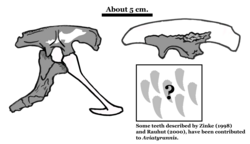Discovery and naming
In 2000 Oliver Walter Mischa Rauhut reported the find of tyrannosauroid material in the lignite coal mine of Guimarota near Leiria, which he referred to Stokesosaurus . [1] Later concluding the distinctiveness of the material justified a separate genus, Rauhut in 2003 named and described it as the type species Aviatyrannis jurassica. [2] The species name was by Rauhut given the intended meaning of "tyrant's grandmother from the Jurassic". [2] The generic name is derived from Latin avia, "grandmother", and tyrannus, "tyrant", on the presumption tyrannis would be its genitive. [2] The specific name means "Jurassic". [2]
The holotype, IPFUB Gui Th 1, was found in a layer of the Alcobaça Formation dating from the early Kimmeridgian, about 155 million years old. It consists of a right ilium. Rauhut in 2003 referred two other bones to Aviatyrannis: IPFUB Gui Th 2, a partial right ilium, and IPFUB Gui Th 3, a right ischium. The referred elements represent slightly larger individuals. Additionally sixteen isolated teeth were referred: IPFUB GUI D 89-91: three teeth of the premaxilla, and IPFUB GUI D 174-186: thirteen teeth of the maxilla and dentary. [2] These had in 1998 been described by Jens Zinke. [3] Rauhut also hypothesised that a number of specimens referred to Stokesosaurus might actually belong to Aviatyrannis. [2]
This page is based on this
Wikipedia article Text is available under the
CC BY-SA 4.0 license; additional terms may apply.
Images, videos and audio are available under their respective licenses.
















